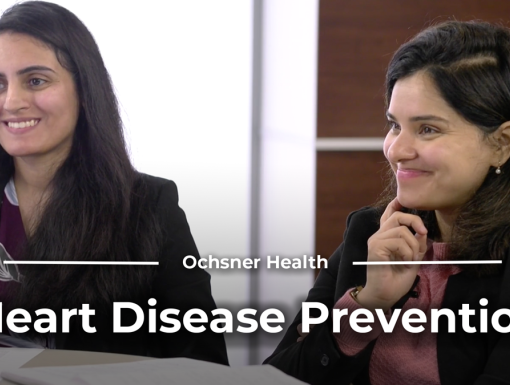
Why Is Heart Disease Risk Higher for Breast Cancer Survivors?
Life after breast cancer brings new opportunities and unique experiences. As more women become long-term survivors thanks to advances in treatment, it's essential to be aware of the connection between breast cancer and heart health.
What is heart disease?
Heart disease isn't just one condition. It's a group of conditions affecting the heart's structure and function. These conditions can include coronary artery disease, heart attacks and heart failure, among others. Heart disease is the leading cause of death for women in the United States, killing 1 in 5 women. Understanding its risk factors is crucial.
Common risk factors include high blood pressure, high cholesterol, smoking, obesity and a sedentary lifestyle. For women, additional factors such as high blood pressure or diabetes in pregnancy, polycystic ovarian syndrome (a cause of infertility), and the presence of rheumatologic diseases such as rheumatoid arthritis and lupus can significantly increase the risk of heart disease.
While some risk factors can be managed with lifestyle changes, others might require medical treatment. The connection between breast cancer and heart disease is particularly important for survivors to consider, as certain treatments can worsen existing risks.
Does breast cancer increase the risk of heart disease?
At first glance, breast cancer and heart disease might seem like unrelated conditions. However, there's a significant overlap in risk factors, and cancer treatments can unintentionally impact heart health.
Studies have shown that heart disease is the leading cause of death in breast cancer survivors, with the highest risk among older survivors and survivors with estrogen-positive breast cancer. Why?
- Heart disease and breast cancer share common risk factors like obesity, smoking and early menopause.
- Treatment for breast cancer, including chemotherapy and radiation, can be toxic to the heart, speeding up the hardening of the arteries. Certain chemotherapy drugs can increase cholesterol and triglyceride levels, causing changes in cholesterol breakdown. The cardiotoxic effects of chemotherapy and radiation, particularly to the left breast near the heart, can lead to heart failure later in life.
- These medicines and radiation can also damage heart tissues and arteries, causing premature heart and valve disease. These risks may begin five years after radiation treatment and continue for up to 30 years. Beyond treatments, other factors play a role. Post-treatment fatigue, stress and weight gain can contribute to heart disease risk.
- Additionally, breast cancer treatments can lead to early menopause, which is associated with an increased risk of heart disease due to reduced estrogen levels. Estrogen plays a protective role in heart health, and its sudden reduction can impact cardiovascular risk.
Most breast cancer diagnoses happen around age 50, which coincides with the beginning of menopause. Menopause and perimenopause itself can raise cholesterol and triglyceride levels. Depression, weight gain and low motivation to exercise are common in both menopause and cancer recovery. Other risk factors, such as high blood pressure, diabetes during adulthood or pregnancy, sleep apnea, high cholesterol and inflammatory conditions like rheumatoid arthritis and lupus, can further increase the risk of heart disease.
What cardiovascular screenings should breast cancer survivors get?
Regular cardiovascular screenings are vital for breast cancer survivors. These screenings can detect early signs of heart disease, allowing for timely intervention. Given the potential cardiotoxicity of cancer treatments, survivors must stay vigilant about their heart health.
Various tests, including echocardiograms, stress tests and blood pressure assessments, can help monitor heart health. An echocardiogram uses ultrasound to assess heart function and heart valve disease, while stress tests evaluate the heart's performance under physical exertion. Routine blood pressure checks can also help manage cardiovascular health.
The frequency of cardiovascular screenings can vary based on individual risk factors and treatment history. Those with higher risk factors or a history of aggressive cancer treatments may require more frequent assessments. Your healthcare team can establish a personalized screening schedule that suits your needs.
What is the best way breast cancer survivors can manage heart disease?
Breast cancer survivors who face heart disease challenges need a holistic approach to manage both conditions effectively. This often involves collaboration between cardiologists, oncologists and gynecologists to ensure comprehensive care. Joint management strategies can improve results by addressing both cancer-related and cardiovascular concerns.
Treatment options for heart disease in breast cancer survivors are like those available for the general population. These may include medications like beta-blockers, ACE inhibitors or lifestyle changes such as dietary modifications, exercise and stress management. Medical and surgical interventions might be necessary in some cases, depending on the severity and type of heart disease. Successful management of both cancer and heart disease requires coordinated care. Regular check-ups and honest conversations about symptoms and treatment progress help specialists work together, ensuring well-rounded and effective care.
How can breast cancer survivors reduce heart disease risk?
Lifestyle changes can play a key role in reducing heart disease risk for breast cancer survivors. Adopting heart-healthy habits supports cardiovascular well-being and contributes to overall quality of life. Prioritizing diet and exercise can significantly impact heart health.
A heart-healthy diet focuses on whole, unprocessed foods rich in fruits, vegetables, lean proteins and whole grains. Reducing sodium, saturated fats and sugars can help maintain healthy blood pressure and cholesterol levels. For breast cancer survivors, a balanced diet can also aid in maintaining energy levels and supporting recovery.
Exercise is another crucial component of heart health. Regular physical activity, such as brisk walking, swimming or yoga, can help manage weight, reduce stress and improve cardiovascular fitness. Aim for at least 150 minutes of moderate-intensity exercise per week, with activities that you enjoy and that fit seamlessly into your lifestyle.
Conclusion
For breast cancer survivors, understanding the link between cancer treatments and heart disease is crucial. By staying informed and proactive, you can manage your risks and prioritize your heart health. Regular screenings, lifestyle adjustments and collaborative care with healthcare professionals can pave the way to a healthier future.
Prioritize your well-being and explore resources that support your recovery and heart health. Partnering with healthcare professionals who understand the unique challenges faced by breast cancer survivors can empower you to make informed decisions. Stay connected with your medical team and continue your commitment to a healthier, more vibrant life.



